
https://www.youtube.com/watch?v=uAfVC4l5uZ0
Is It Safe to Take 10,000 IU of Vitamin D3 Dr. Berg Explains
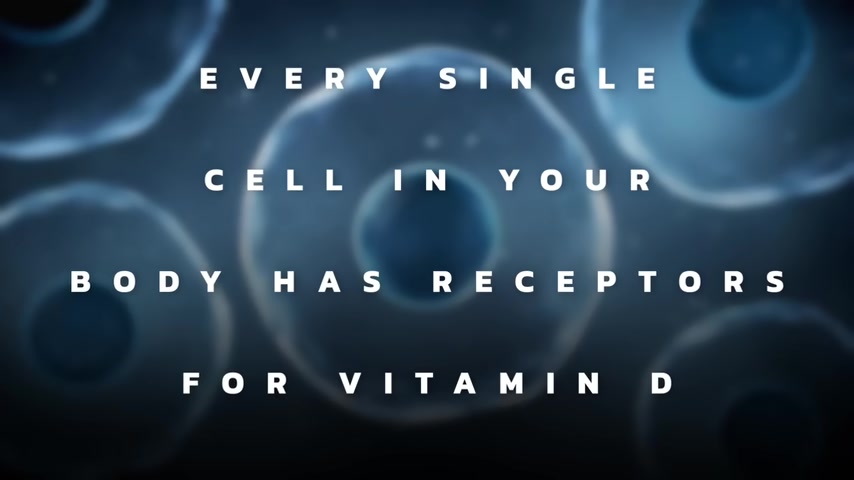
So is it really that safe to take 10,000 IUs of vitamin d every single day ?
That's what we're gonna talk about .
Did you know that every single cell and tissue in your body has receptors for vitamin d ?
And yet , there's actually still no medical consensus or agreement on what a vitamin d deficiency really is .
So I even think a better question than is , 10,000 IU's of vitamin d safe , we should ask , is it actually safe to be deficient in vitamin d ?
The great majority of the population is deficient , and they have all sorts of problems ranging from a lowered immune system to arthritis to autoimmune problems and inflammation , depression , high blood pressure .
And most of the research that came up with the RDAs for vitamin d , I think roughly it's about 600 IUs , were based on preventing , rickets , things like that .

But not therapeutically to address all the other issues like autoimmune problems and severe infections .
So there's a couple very important things for you to know .
Number 1 , vitamin d toxicity is very rare .
Okay .
That's number 1 .
Number 2 , the symptoms for vitamin d toxicity are almost identical to a vitamin k two deficiency .
In other words , do you really have too much vitamin d or just not enough vitamin k 2 ?
Vitamin k 2 addresses 2 proteins mainly , and it mainly had to do with the transportation of calcium .
So vitamin d helps the absorption of calcium from your gut into your blood by a factor of 20 x .
And then vitamin k 2 drives that calcium from the arteries into the bone .

So , 2 big functions of vitamin k 2 is keeping calcium out of the soft tissues , Not just the arteries , but the joints , the kidneys , the lungs , other tissues , as well as making your bones really , really solid .
I'm talking about dealing with osteopenia or osteoporosis .
You can't fix osteopenia and osteoporosis with vitamin D .
Vitamin d doesn't even prevent fractures .
Vitamin k 2 is the key nutrient .
So when I did a deep dive in this , I think I found the main confusion with vitamin d toxicity .
It has to do with this thing called international units .
It's this confusing measurement of vitamin d .
So what actually is an international unit ?
Is it actually a measurement of some mass or volume or weight or something ?
The answer is absolutely not .
It's an arbitrary number that was agreed on from some committee .
So I'll give you just a couple examples .


If we take 1 international unit of vitamin e , that would come out to 0.67 milligrams .
Now what about 1 international unit of vitamin a ?
Well , there's 2 types of vitamin a .
Well , you have the precursor to vitamin a , which is beta carotene , and then you also have the actual , bioactive form of vitamin a , which is retinol .
So , check this out .
One international unit of beta carotene equals point 6 micrograms .
And 1 international unit of retinol equals point 3 micrograms .
One international unit of vitamin d equals 0.025 micrograms .
That's like a quarter of 1 milligram .
So you can see it's very confusing , and I think they're trying to get rid of it .
And , you know , just the sound of 10,000 IUs sounds like a lot , but you're dealing with just a quarter of a microgram .
You see , the big problem with vitamin d is there's a lot of barriers to entry to absorption .
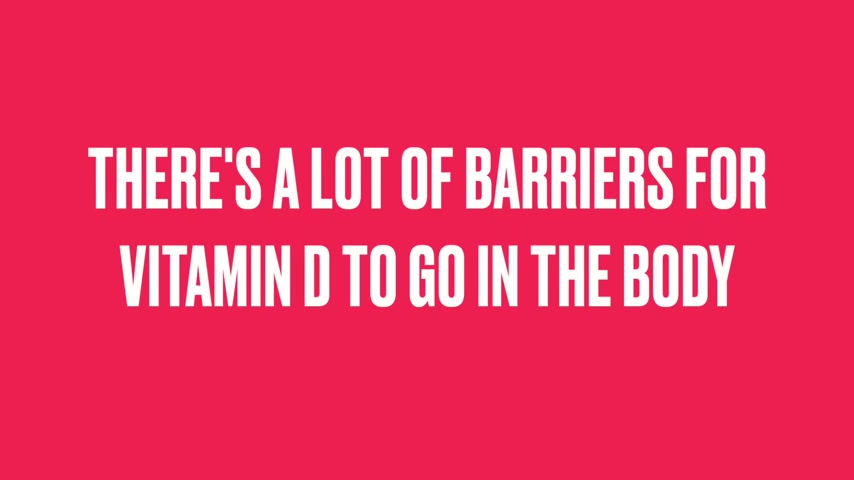
Skin color , the darker your skin is , the harder it is to absorb vitamin d .
Your age , how much weight you have if you're obese , insulin resistance , how much stress you have .
If you have any type of genetic issue that is blocking vitamin d , which is very , very common , that's a big barrier .
You also have where you live , the latitude on the planet .
You also have the season .
I mean , one really interesting thing about d , if you go to PubMed and you just type in seasonal diseases , wow , you're gonna find all sorts of fascinating research related to vitamin d .
Or even latitude diseases .
Massive amount of data .
Also , the more unhealthy the liver is or your gallbladder .
If if you have the gallbladder removed and you don't have the bile to absorb it , that could be an issue .
Or if there's inflammation in your gut that you can't absorb it .
So , there's a lot of barriers for this vitamin d to go on the body .
So if you're like me , it's kind of a hassle to go get a prescription for vitamin d .
Go to some , like , Labcorp and get your blood drawn and get a blood test .
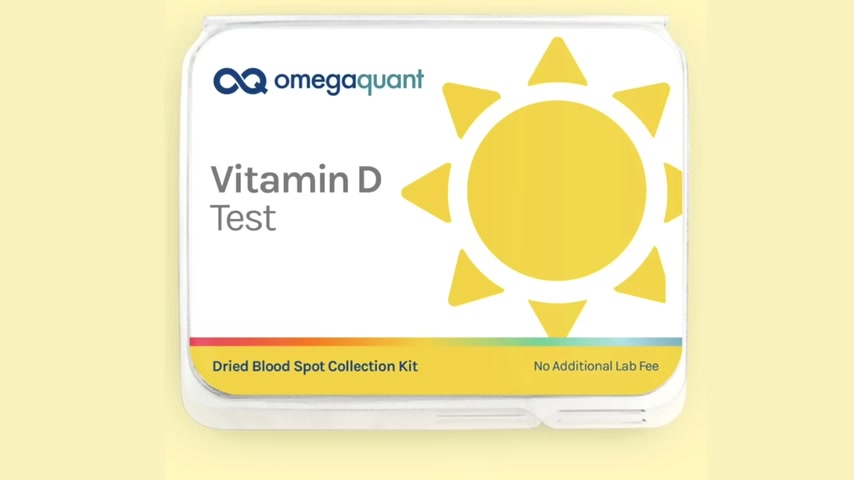
There's a much better test .
It's a home test .
It's a blood spot test .
And I use this company right here , Omega Quant .
It's a blood spot .
So basically , it's a way to take a pinprick of your blood , put it on this little piece of paper , stick it in this kit , send it to them , they send it back .
I don't have to get a prescription .
I don't have to go to LabCorp to get my blood drawn .
It's really really convenient .
So I contacted this company and they wanted to know if I wanted to be an affiliate .
I said no .
But I would like my viewers to get a discount on this test .
So if you click down below , there'll be a code .
You'll get the discount .
Not me .
I'm not gonna get an affiliate , commission .
And that way , you can save a little bit on the test .
But there's over 53,000 , last time I checked , studies in vitamin d and PubMed alone .
Crazy amount of research .
And vitamin d , is intimately involved in your immune system .
And , I just wanna mention one part of the immune system called the T helper cell .

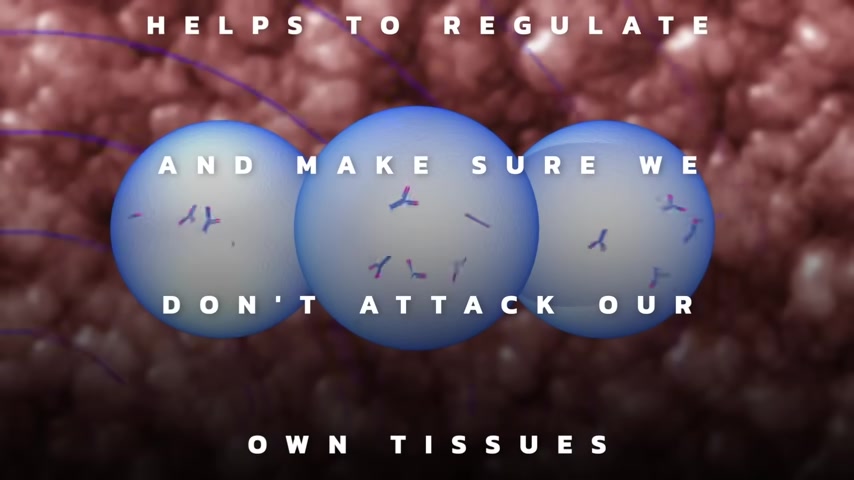
The T helper cell helps to regulate and make sure that we don't attack our own tissues .
It's kind of like differentiating self from non self .
And if there's confusion in this area and this cell can't work , potentially you can develop an autoimmune disease , which is your own cells or your immune system attacking itself .
And it just so happens that vitamin d has a big responsibility of making sure that cell works .
I mean , even inside your immune cells , they have the ability to convert the inactive to the active form of vitamin d .
So you can imagine how important this is .
And another point is that we've been told to stay out of the sun in the summer .
Right ?
Use sunscreen , hats , and coats , and just cover ourselves .
I I mean , this is like an interesting thing to look at .
I mean , it stirs up a lot of controversy because everyone knows that the sun is bad , but is it really ?
Well , you're thinking about skin cancer .
Right ?
Have you ever heard of the skin cancer paradox ?
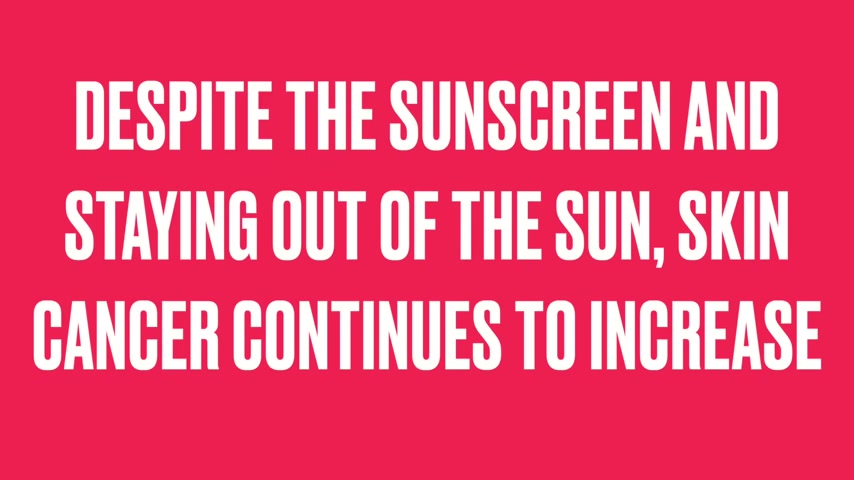
So despite the sunscreen , despite staying out of the sun , skin cancer continues to increase .
We assume that it's coming from the radiation , but really is it ?
Vitamin d has a protective element against melanoma .
So if the sun's rays radiation were really responsible for this , then we would have seen a decrease in cancer not an increase .
Also , vitamin d is really important for your lung .
Okay ?
It helps to modulate your immune system to make sure that that immune system is not overreacting or underreacting .
So it's really good for anything related to lung like COPD , asthma , things like that .
And there's also doctors that are well recognized that will recommend taking 50,000 IUs of vitamin d at the first sign of a cold or flu symptoms .
Let's look at this chart right here .
This is based on some data .
I'm gonna put all the links down below , but we have the amounts or doses of vitamin d , a1000000 .
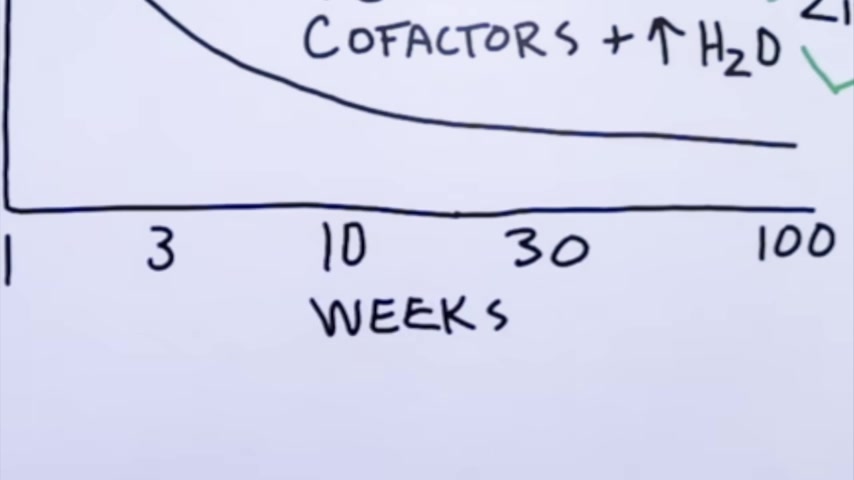
We have 300,000 , a 100,000 , 30,000 , and 10,000 .
Okay ?
And this is not scaled .
But you can see that these are in weeks and this is the amounts .
So we have 1 week , 3 week , 10 week , 30 week , a 100 week .
How many weeks are in a year ?
52 , right ?
That's gonna be right here .
So , this is about a year right here .
So , check this out .
You can see the toxicity level right here .
You'd have to take a 100,000 IUs of vitamin d for a period of time before it becomes toxic .
But what I want you to look at right here is this line right through here .
This actually is considered safe if you adjust for the cofactors .
In other words , there are certain nutrients that vitamin d uses to help , prevent complications like vitamin k 2 which I've already mentioned , like magnesium and zinc .
So , these three nutrients are very important to take with your vitamin d .
It doesn't even have to be taken exactly with it at the same time , but , sometime around .

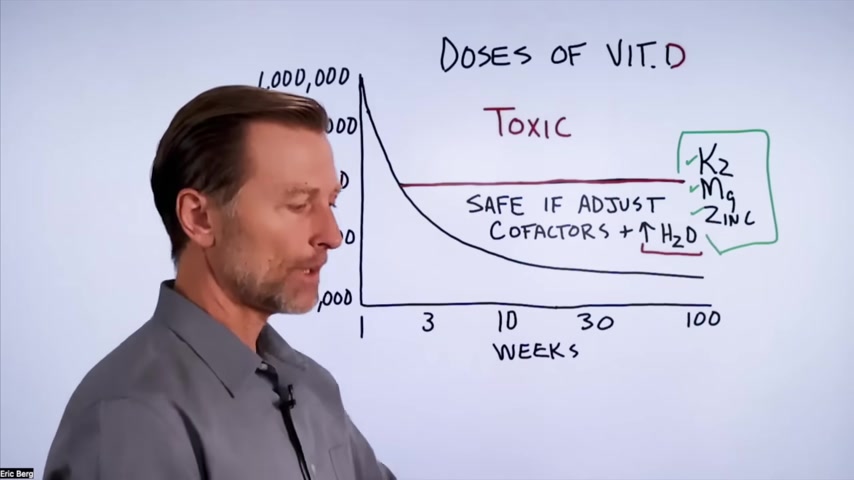
You just wanna make sure you're not deficient in these because all of these help to make vitamin d more active and prevent the toxicity effect .
Don't wanna forget about increasing water too because one potential toxic effect could be kidney stones .
But if you're drinking minimally 2 and a half liters of fluid per day , you can very easily prevent kidney stones and keep your , your urine diluted so these calcium stones don't develop , despite if you have high levels of calcium in the urine .
Now what should a normal level of calcium be ?
Okay .
When you get it checked , should be between 90 a100 nanomoles per liter or there's another measurement you can use which is 35 to 40 ng's per milliliter .
Okay .
So depending on what lab you're using and what units .
So , I hope you feel a little more comfortable of it with vitamin D taking 10,000 or even more .

I have a really good , summary of what I just talked about in a 2 page document .
If you wanna download it for free , I put the link down below .
Check it out .
Are you looking for a way to reach a wider audience and get more views on your videos?
Our innovative video to text transcribing service can help you do just that.
We provide accurate transcriptions of your videos along with visual content that will help you attract new viewers and keep them engaged. Plus, our data analytics and ad campaign tools can help you monetize your content and maximize your revenue.
Let's partner up and take your video content to the next level!
Contact us today to learn more.